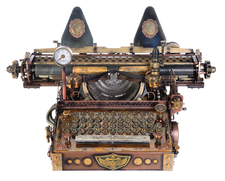An input device for keyboard shortcuts
Open Hardware – Palitra

© Lead Image © 3355m, 123RF.com
For even simpler keyboard shortcuts, the prospective Palitra allows you to create simple macros with a programmable USB device.
The keyboard is by far the most efficient way to interact with a computer. Pressing keys is faster than a mouse or trackball and reduces repetitive stress injuries, as well. For many, these advantages make learning keyboard shortcuts well worth the effort. Unfortunately, most non-gaming keyboards lack separate programmable keys, and shortcuts are often complex key combinations. Michele Balistreri's forthcoming Palitra offers simpler shortcuts: a programmable USB device for storing several dozen shortcuts. Palitra is scheduled for a crowdfunding campaign to assist manufacturing [1].
When he was 13, Balistreri first encountered open source software in a Corel Linux CD included in an Italian magazine. Since then, he has contributed to MPlayer and the icculus fork of Quake 2, briefly maintained KDE packages for Gentoo Linux, developed embedded software, and designed hardware.
Working as a fashion photographer inspired Balistreri to develop Palitra. He explains, "As a photographer, I spend a lot of time retouching, using a Wacom tablet and a keyboard for shortcuts. However, the typical keyboard is rather large and some combinations are hard to activate with one hand (especially being left handed). Often, my hand gets in the way of the stylus [for the tablet], and I cannot keep it constantly on the keyboard. To avoid shoulder ache and time wasting, I decided that I needed a small input device, which could be placed next to the tablet and programmed with all the shortcuts I need."
[...]
Buy this article as PDF
(incl. VAT)
Buy Linux Magazine
Subscribe to our Linux Newsletters
Find Linux and Open Source Jobs
Subscribe to our ADMIN Newsletters
Support Our Work
Linux Magazine content is made possible with support from readers like you. Please consider contributing when you’ve found an article to be beneficial.

News
-
Two New Distros Adopt Enlightenment
MX Moksha and AV Linux 25 join ranks with Bodhi Linux and embrace the Enlightenment desktop.
-
Solus Linux 4.8 Removes Python 2
Solus Linux 4.8 has been released with the latest Linux kernel, updated desktops, and a key removal.
-
Zorin OS 18 Hits over a Million Downloads
If you doubt Linux isn't gaining popularity, you only have to look at Zorin OS's download numbers.
-
TUXEDO Computers Scraps Snapdragon X1E-Based Laptop
Due to issues with a Snapdragon CPU, TUXEDO Computers has cancelled its plans to release a laptop based on this elite hardware.
-
Debian Unleashes Debian Libre Live
Debian Libre Live keeps your machine free of proprietary software.
-
Valve Announces Pending Release of Steam Machine
Shout it to the heavens: Steam Machine, powered by Linux, is set to arrive in 2026.
-
Happy Birthday, ADMIN Magazine!
ADMIN is celebrating its 15th anniversary with issue #90.
-
Another Linux Malware Discovered
Russian hackers use Hyper-V to hide malware within Linux virtual machines.
-
TUXEDO Computers Announces a New InfinityBook
TUXEDO Computers is at it again with a new InfinityBook that will meet your professional and gaming needs.
-
SUSE Dives into the Agentic AI Pool
SUSE becomes the first open source company to adopt agentic AI with SUSE Enterprise Linux 16.

